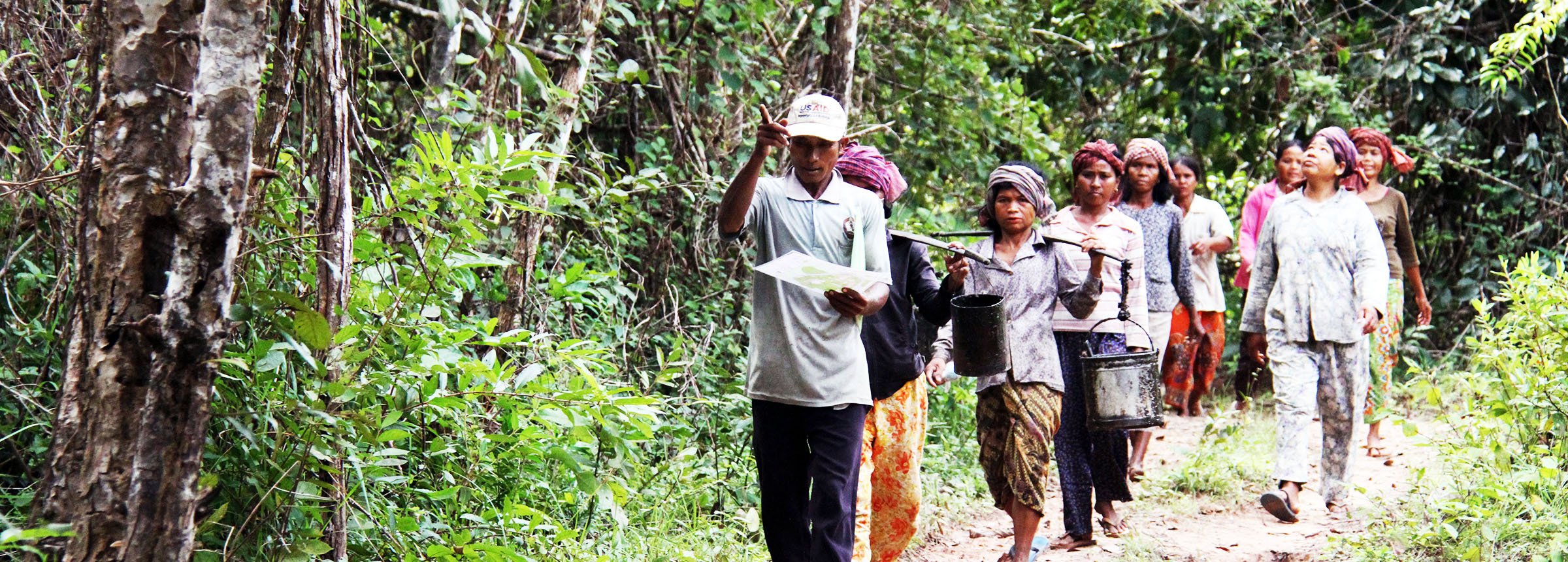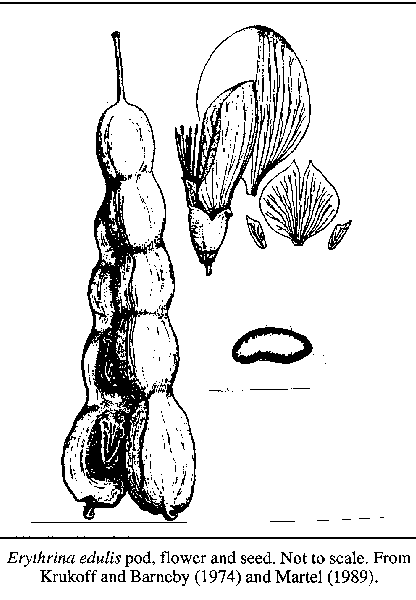
Erythrina edulis: multipurpose tree for tropical highlands
NFTA 94-01, January 1994
A quick guide to nitrogen fixing trees from around the world
Cultivated for centuries, Erythrina edulis is an important food source for humans and animals in the tropical highlands of South America. The seed is a component of many diets,and the trees also provide shade in coffee and cacao plantations, support for vine crops, green manure, live fenceposts, wood for construction and fuel, and medicinal preparations.
 Botany
Botany
Erythrina edulis Triana ex M. Micheli is one of about 115 Erythrina species in the subfamily Papilionoideae of the Leguminosae (syn. Fabaceae) family. Over a normal life span of 30 to 40 years, the leafy trees grow up to 14 m tall with stem diameters up to 37 cm and crown diameters up to 7 m. The stem and branches are covered with stout prickles. The alternate leaves are trifoliate with long petioles and two nectar-producing glands at the base of each leaflet. The flower cluster (raceme), supported on a stout stalk, consists of 180 to 200 short-stalked flowers arranged in threes around the axis. The flowers have a reddish-green calyx and a crimson corolla with an upper petal (standard) and two lateral petals forming the keel. The pistil is surrounded by 10 stamens. The two-petaled flowers face upward, forming a large cup in which nectar gathers (Ruskin, 1989).
Erythrina edulis is cross pollinated by sucking insects, bees, wasps and birds. Seeds mature 65 days after flowering. Fruits hang in bunches of 9 and 18 cylindrical pods. Pod size varies widely, but averages 32 cm long and 3 cm in diameter with six seeds. The seed coat is generally brownish-red but is sometimes yellow or black (Acero, 1989).
Distribution
Erythrina edulis is distributed from Mérida in Venezuela, to the mountain ranges of Colombia and the Andes mountains of Ecuador, Peru and Bolivia. It is commonly known as chachafruto, balú, basul or sachaporoto in Colombia, guato in Ecuador, and pashuro, pajuro, basul sachaporoto or sacha purutu in Argentina and Bolivia (Ruskin, 1989).
Ecology
Erythrina edulis is a pioneer species that grows best in full sunlight, but trees can tolerate some shade in the early stages of growth. In Colombia, the species occurs from elevations of 1200 to 2600 m, with an optimum range from 1600 to 2200 m. In Peru, E. edulis grows from 900 to 3200 m (Martel, 1989). In the species’s native range, annual rainfall varies from 450 to 1800 mm and temperatures are between 5° and 25°C. The trees grow well in loose-textured sandy loams and in heavy clay soils. They do not tolerate frequent frosts.
Uses
Human food. The seeds contain 23% protein, 1% fat, 8% crude fiber and 84% moisture. They have a good balance of amino acids and a digestibility after cooking of about 50%. Seeds must be boiled at least 45 minutes or fried thoroughly before being eaten. As a paste, they provide a nutritious base for tortillas, desserts, pies, soups and food for infants. They are also boiled, sun dried, ground and added to flour. Research indicates that uncooked E. edulis seeds can be toxic if consumed over a long period (Pérez et al., 1979). Seeds of all other Erythrina species are highly toxic.
Forage. The leaves and tender branches can be fed to cattle, goats, horses, pigs, guinea pigs and rabbits. Leaves contain 24% protein, 29% crude fiber (dry weight) and 21% total carbohydrates. They are rich in potassium but low in calcium (Surco, 1987). Seeds and pods can be fed fresh to cattle and goats, but should be cooked before feeding to pigs, chickens, rabbits or fish. The pods contain 21% protein, 23% crude fiber (dry weight), 24% carbohydrates and 91% moisture. Cooked seed can replace up to 60% of the concentrate fed to chickens and fish (Martín and Falla, 1991).
For maximum fodder production, the trees can be planted in protein banks at a close spacing (1.0 x 0.5 m). They are first pruned at 10 months and then at six- or four-month intervals. A two-year-old protein bank can produce up to 80 tons of leaves and tender branches per ha, or the leaves can be dried and ground to produce 6 tons of chicken feed rich in carotene (Vargas and Ocampo, 1991).
Shade and support. Erythrina edulis is widely used as a shade tree for coffee or as a support for vine crops such as pepper, betel and grape. In Colombia, trees are spaced at 6 x 6 to 8 x 8 m in coffee plantations or 5 x 5 m with vine crops (Vargas and Ocampo, 1991). Annual pod production from three- to four-year-old trees at a 6 x 6 m spacing can average 30 kg/tree or 8 tons/ha (green weight); annual pod production from 20-year-old trees can average 177 to 211 kg/tree.
Live fenceposts. In Colombia, live fenceposts are established from stakes at 2-m intervals and allowed to grow for 30 months before pruning or attaching barbed wire. Stakes should be at least 4 to 6 cm in diameter and 2 m long. Pruned at four-month intervals, leafy branches from 1 km of fencing can provide up to 30 tons of fodder per year; unpruned, the same fenceposts can provide up to 85 tons of fruit (Vargas and Ocampo, 1991).
Medicine. In Colombia, a soap made from the bark, branches and leaves of E. edulis is used to wash dogs with skin disease. In Peru, the seed is mixed in a liquid concoction to treat inflammation of the bladder. The flowers are used to treat eye irritations (Acero, 1989).
Silviculture
Seed treatment. Erythrina edulis is easily propagated from seed or cuttings, but seedlings tend to root deeper and live longer than cuttings. Seed should be removed from pods immediately and stored in paper bags in a cool, dark place. They lose viability quickly and should be planted within eight days of harvesting. Viability can be extended up to 20 days by dipping seeds for a moment in molten paraffin so that a thin layer of paraffin coats the entire seed. Seed size varies widely: Acero (1989) reports 60 fresh seeds per kg in Colombia, while Martel (1989) reports 146 fresh seeds per kg in Peru.
Establishment. Larger seeds tend to produce more vigorous seedlings. Plant seeds in 1-kg polyethylene bags with the convex side facing upwards and slightly exposed. Leave room between planting bags to allow space for leaf development (Vargas and Ocampo, 1991). Germination begins in 5 to10 days. Shade the seedlings in the nursery and reduce shade partially in the last two weeks before outplanting. At 60 days, seedlings may be planted out in holes 30 cm deep.
Erythrina edulis can also be direct seeded.Cultivate the soil thoroughly to a depth of 30 cm and plant two seeds per hole. Thin to one seedling after four or five weeks. Weed periodically in a 1-m circle around the plants. Seedlings grow rapidly (2.5 m in the first year) and begin producing fruit in approximately 24 to 27 months.
Cuttings of 4 to 6 cm diameter, and usually 1 m in length, should be planted to a depth of 30 to 50 cm within three days of harvesting (Vargas and Ocampo, 1991). Cuts should be made with well-sharpened tools to avoid damage that can lead to rotting; the top cut should be at a 45° angle. Sealing the cuts with paraffin, plastic, mud or other material can increase survival rates. Cuttings begin producing fruit about 18 months after planting.
Erythrina edulis forms a nitrogen-fixing symbiosis with Rhizobium in the cowpea miscellany (Acero, 1989). Large nodules form in the upper soil surface and decrease in size with increasing soil depth.
Limitations
Erythrina edulis does not tolerate long periods of drought, especially during early stages of establishment. It does not grow well in strongly acidic soils (pH below 4.5). Stem borers damage terminal shoots and cause lateral branching. Butterfly larvae (Terastia meticulosalis) bore into seeds. Trees are also susceptible to nematodes (Helicotylenchus sp., Hoplotylus sp. and Meloidogyne sp.) (Francia Varon de Agudelo, personal communication).
Future research needs
The large differences observed in seed size suggest the existence of genetic variation. Rangewide provenance collection and testing is needed to determine differences in fruit yield, biomass production, nutrient content and adaptability. Research would also be useful on improved methods to increase seed viability. Symbiotic relationships need to be explored and quantified. Finally, traditional agroforestry uses of E. edulis and pest and ,disease management need further documentation.
References
Acero, E. 1989. Informe final silvicultura y productividad del chachafruto Erythrina edulis. Part 1. Bogotá: Universidad Distrital-CIID-CONIF.
Krukoff, B.A. and Barneby, R.C. 1974. Conspectus of species of the genus Erythrina. LLOYDIA (Journal of Natural Products). 37:359.
Martel, A. 1989. Erythrina edulis Triana, especie de gran potencial para asociaciones agrofrestales; advances de su propagación. Technical Note 01. FAO/Holland/DGFF Project, 30 pp.
Martín, D. and Falla, J.A. 1991. Evaluación de los efectos biológicos de la sustitución de concentrado por harina de chachafruto Erythrina edulis (15 y 30%) en la alimentación de pollos de engorde bajo un esquema de producción de economía campesina. Thesis in Zootechnology. Valle (Colombia): Universidad Nacional de Colombia-Palmira.
Patiño, J.E. 1992. Suplementación de cabras con chachafruto Erythrina edulis.Thesis in Zootechnology. Valle (Colombia): Universidad Nacional de Colombia-Palmira.
Pérez, G., de Martínez, C. and Díaz, E. 1979. Evaluación de la calidad de la proteína del chachafruto Erythrina edulis. Bogotá: Universidad Nacional de Colombia.
Ruskin, F.R. 1989. Basul. In Lost crops of the Incas. Washington, DC: National Academy Press, pp. 164–71.
Surco, J. 1987. Evaluación de minerales nutricios en las semilla de Erythrina edulis. Cuzco (Peru): Universidad Nacional San Antonio Abad del Cuzco.
Vargas, L.R. and Ocampo, M.P., eds. 1991. El chachafruto o balú—protector de aguas y suelos superalimento humano, forraje para el ganado. Extension Bulletin 7. Bogotá: Federación Nacional de Cafeteros de Colombia, p. 22.
Written by Nancy Barrera, Universidad Nacional de Colombia-Palmira, A.A. 237 Palmira, Valle, Colombia, with material added by NFTA staff.
A publication of the Forest, Farm, and Community Tree Network (FACT Net) (formerly the Nitrogen Fixing Tree Association)
